Jian Song
DisasterM3: A Remote Sensing Vision-Language Dataset for Disaster Damage Assessment and Response
May 27, 2025Abstract:Large vision-language models (VLMs) have made great achievements in Earth vision. However, complex disaster scenes with diverse disaster types, geographic regions, and satellite sensors have posed new challenges for VLM applications. To fill this gap, we curate a remote sensing vision-language dataset (DisasterM3) for global-scale disaster assessment and response. DisasterM3 includes 26,988 bi-temporal satellite images and 123k instruction pairs across 5 continents, with three characteristics: 1) Multi-hazard: DisasterM3 involves 36 historical disaster events with significant impacts, which are categorized into 10 common natural and man-made disasters. 2)Multi-sensor: Extreme weather during disasters often hinders optical sensor imaging, making it necessary to combine Synthetic Aperture Radar (SAR) imagery for post-disaster scenes. 3) Multi-task: Based on real-world scenarios, DisasterM3 includes 9 disaster-related visual perception and reasoning tasks, harnessing the full potential of VLM's reasoning ability with progressing from disaster-bearing body recognition to structural damage assessment and object relational reasoning, culminating in the generation of long-form disaster reports. We extensively evaluated 14 generic and remote sensing VLMs on our benchmark, revealing that state-of-the-art models struggle with the disaster tasks, largely due to the lack of a disaster-specific corpus, cross-sensor gap, and damage object counting insensitivity. Focusing on these issues, we fine-tune four VLMs using our dataset and achieve stable improvements across all tasks, with robust cross-sensor and cross-disaster generalization capabilities.
Enhancing Monocular Height Estimation via Sparse LiDAR-Guided Correction
May 11, 2025Abstract:Monocular height estimation (MHE) from very-high-resolution (VHR) remote sensing imagery via deep learning is notoriously challenging due to the lack of sufficient structural information. Conventional digital elevation models (DEMs), typically derived from airborne LiDAR or multi-view stereo, remain costly and geographically limited. Recently, models trained on synthetic data and refined through domain adaptation have shown remarkable performance in MHE, yet it remains unclear how these models make predictions or how reliable they truly are. In this paper, we investigate a state-of-the-art MHE model trained purely on synthetic data to explore where the model looks when making height predictions. Through systematic analyses, we find that the model relies heavily on shadow cues, a factor that can lead to overestimation or underestimation of heights when shadows deviate from expected norms. Furthermore, the inherent difficulty of evaluating regression tasks with the human eye underscores additional limitations of purely synthetic training. To address these issues, we propose a novel correction pipeline that integrates sparse, imperfect global LiDAR measurements (ICESat-2) with deep-learning outputs to improve local accuracy and achieve spatially consistent corrections. Our method comprises two stages: pre-processing raw ICESat-2 data, followed by a random forest-based approach to densely refine height estimates. Experiments in three representative urban regions -- Saint-Omer, Tokyo, and Sao Paulo -- reveal substantial error reductions, with mean absolute error (MAE) decreased by 22.8\%, 6.9\%, and 4.9\%, respectively. These findings highlight the critical role of shadow awareness in synthetic data-driven models and demonstrate how fusing imperfect real-world LiDAR data can bolster the robustness of MHE, paving the way for more reliable and scalable 3D mapping solutions.
Beyond Timesteps: A Novel Activation-wise Membrane Potential Propagation Mechanism for Spiking Neural Networks in 3D cloud
Feb 18, 2025



Abstract:Due to the similar characteristics between event-based visual data and point clouds, recent studies have emerged that treat event data as event clouds to learn based on point cloud analysis. Additionally, some works approach point clouds from the perspective of event vision, employing Spiking Neural Network (SNN) due to their asynchronous nature. However, these contributions are often domain-specific, making it difficult to extend their applicability to other intersecting fields. Moreover, while SNN-based visual tasks have seen significant growth, the conventional timestep-wise iterative activation strategy largely limits their real-world applications by large timesteps, resulting in significant delays and increased computational costs. Although some innovative methods achieve good performance with short timesteps (<10), few have fundamentally restructured the update strategy of spiking neurons to completely overcome the limitations of timesteps. In response to these concerns, we propose a novel and general activation strategy for spiking neurons called Activation-wise Membrane Potential Propagation (AMP2). This approach extends the concept of timesteps from a manually crafted parameter within the activation function to any existing network structure. In experiments on common point cloud tasks (classification, object, and scene segmentation) and event cloud tasks (action recognition), we found that AMP2 stabilizes SNN training, maintains competitive performance, and reduces latency compared to the traditional timestep-wise activation paradigm.
OpenEarthMap-SAR: A Benchmark Synthetic Aperture Radar Dataset for Global High-Resolution Land Cover Mapping
Jan 18, 2025



Abstract:High-resolution land cover mapping plays a crucial role in addressing a wide range of global challenges, including urban planning, environmental monitoring, disaster response, and sustainable development. However, creating accurate, large-scale land cover datasets remains a significant challenge due to the inherent complexities of geospatial data, such as diverse terrain, varying sensor modalities, and atmospheric conditions. Synthetic Aperture Radar (SAR) imagery, with its ability to penetrate clouds and capture data in all-weather, day-and-night conditions, offers unique advantages for land cover mapping. Despite these strengths, the lack of benchmark datasets tailored for SAR imagery has limited the development of robust models specifically designed for this data modality. To bridge this gap and facilitate advancements in SAR-based geospatial analysis, we introduce OpenEarthMap-SAR, a benchmark SAR dataset, for global high-resolution land cover mapping. OpenEarthMap-SAR consists of 1.5 million segments of 5033 aerial and satellite images with the size of 1024$\times$1024 pixels, covering 35 regions from Japan, France, and the USA, with partially manually annotated and fully pseudo 8-class land cover labels at a ground sampling distance of 0.15--0.5 m. We evaluated the performance of state-of-the-art methods for semantic segmentation and present challenging problem settings suitable for further technical development. The dataset also serves the official dataset for IEEE GRSS Data Fusion Contest Track I. The dataset has been made publicly available at https://zenodo.org/records/14622048.
BRIGHT: A globally distributed multimodal building damage assessment dataset with very-high-resolution for all-weather disaster response
Jan 10, 2025



Abstract:Disaster events occur around the world and cause significant damage to human life and property. Earth observation (EO) data enables rapid and comprehensive building damage assessment (BDA), an essential capability in the aftermath of a disaster to reduce human casualties and to inform disaster relief efforts. Recent research focuses on the development of AI models to achieve accurate mapping of unseen disaster events, mostly using optical EO data. However, solutions based on optical data are limited to clear skies and daylight hours, preventing a prompt response to disasters. Integrating multimodal (MM) EO data, particularly the combination of optical and SAR imagery, makes it possible to provide all-weather, day-and-night disaster responses. Despite this potential, the development of robust multimodal AI models has been constrained by the lack of suitable benchmark datasets. In this paper, we present a BDA dataset using veRy-hIGH-resoluTion optical and SAR imagery (BRIGHT) to support AI-based all-weather disaster response. To the best of our knowledge, BRIGHT is the first open-access, globally distributed, event-diverse MM dataset specifically curated to support AI-based disaster response. It covers five types of natural disasters and two types of man-made disasters across 12 regions worldwide, with a particular focus on developing countries where external assistance is most needed. The optical and SAR imagery in BRIGHT, with a spatial resolution between 0.3-1 meters, provides detailed representations of individual buildings, making it ideal for precise BDA. In our experiments, we have tested seven advanced AI models trained with our BRIGHT to validate the transferability and robustness. The dataset and code are available at https://github.com/ChenHongruixuan/BRIGHT. BRIGHT also serves as the official dataset for the 2025 IEEE GRSS Data Fusion Contest.
Age Optimal Sampling for Unreliable Channels under Unknown Channel Statistics
Dec 24, 2024Abstract:In this paper, we study a system in which a sensor forwards status updates to a receiver through an error-prone channel, while the receiver sends the transmission results back to the sensor via a reliable channel. Both channels are subject to random delays. To evaluate the timeliness of the status information at the receiver, we use the Age of Information (AoI) metric. The objective is to design a sampling policy that minimizes the expected time-average AoI, even when the channel statistics (e.g., delay distributions) are unknown. We first review the threshold structure of the optimal offline policy under known channel statistics and then reformulate the design of the online algorithm as a stochastic approximation problem. We propose a Robbins-Monro algorithm to solve this problem and demonstrate that the optimal threshold can be approximated almost surely. Moreover, we prove that the cumulative AoI regret of the online algorithm increases with rate $\mathcal{O}(\ln K)$, where $K$ is the number of successful transmissions. In addition, our algorithm is shown to be minimax order optimal, in the sense that for any online learning algorithm, the cumulative AoI regret up to the $K$-th successful transmissions grows with the rate at least $\Omega(\ln K)$ in the worst case delay distribution. Finally, we improve the stability of the proposed online learning algorithm through a momentum-based stochastic gradient descent algorithm. Simulation results validate the performance of our proposed algorithm.
Laser Ultrasonic Imaging via the Time Domain Linear Sampling Method
Dec 08, 2024Abstract:This study investigates the imaging ability of the time-domain linear sampling method (TLSM) when applied to laser ultrasonic (LU) tomography of subsurface defects from limited-aperture measurements. In this vein, the TLSM indicator and it spectral counterpart known as the multifrequency LSM are formulated within the context of LU testing. The affiliated imaging functionals are then computed using synthetic and experimental data germane to LU inspection of aluminum alloy specimens with manufactured defects. Hyperparameters of inversion are computationally analyzed. We demonstrate using synthetic data that the TLSM indicator has the unique ability to recover weak (or hard-to-reach) scatterers and has the potential to generate higher quality images compared to LSM. Provided high-SNR measurements, this advantage may be preserved in reconstructions from LU test data.
Modeling of UV NLoS Communication Channels: From Atmospheric Scattering and Obstacle Reflection Perspectives
Nov 08, 2024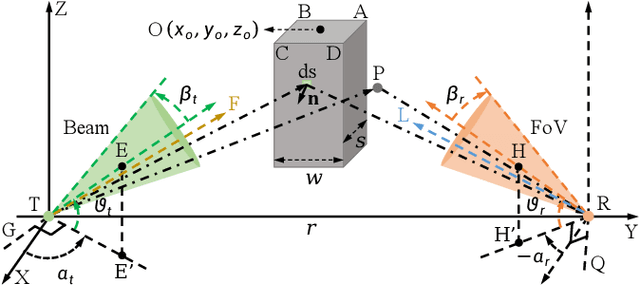
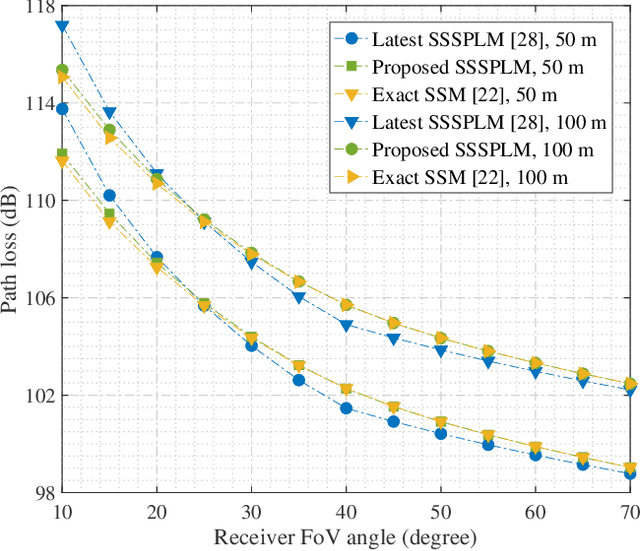
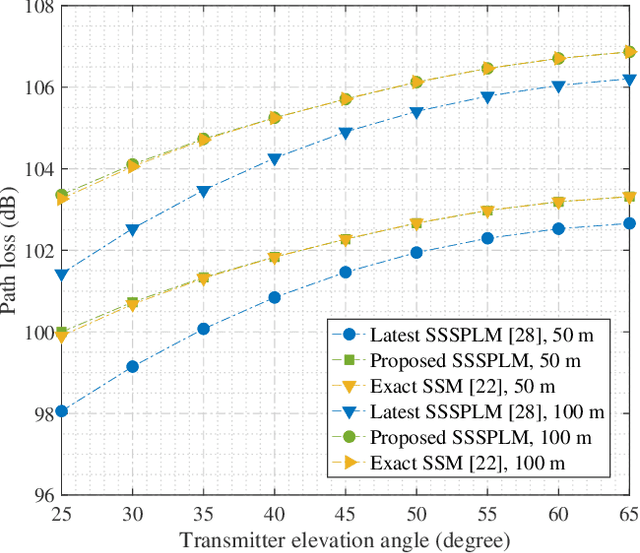
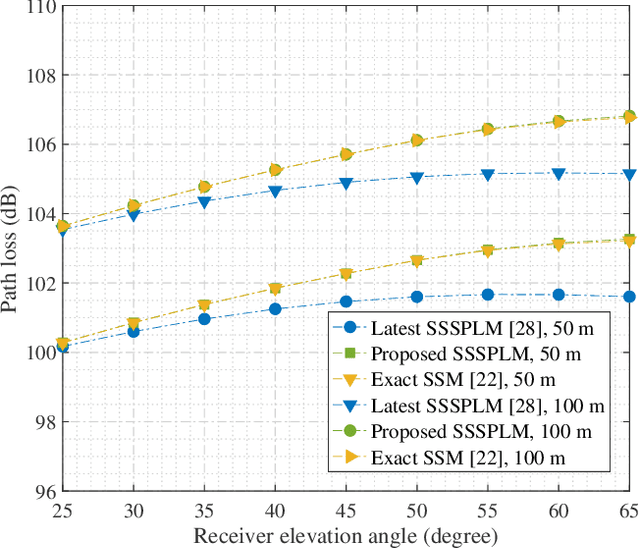
Abstract:As transceiver elevation angles increase from small to large, existing ultraviolet (UV) non-line-of-sight (NLoS) models encounter two challenges: i) cannot estimate the channel characteristics of UV NLoS communication scenarios when there exists an obstacle in the overlap volume between the transmitter beam and the receiver field-of-view (FoV), and ii) cannot evaluate the channel path loss for the wide beam and wide FoV scenarios with existing simplified single-scattering path loss models. To address these challenges, a UV NLoS scattering model incorporating an obstacle was investigated, where the obstacle's orientation angle, coordinates, and geometric dimensions were taken into account to approach actual application environments. Then, a UV NLoS reflection model was developed combined with specific geometric diagrams. Further, a simplified single-scattering path loss model was proposed with a closed-form expression. Finally, the proposed models were validated by comparing them with the Monte-Carlo photon-tracing model, the exact single-scattering model, and the latest simplified single-scattering model. Numerical results show that the path loss curves obtained by the proposed models agree well with those attained by related NLoS models under identical parameter settings, and avoiding obstacles is not always a good option for UV NLoS communications. Moreover, the accuracy of the proposed simplified model is superior to that of the existing simplified model for all kinds of transceiver FoV angles.
Channel Modeling for Ultraviolet Non-Line-of-Sight Communications Incorporating an Obstacle
Nov 08, 2024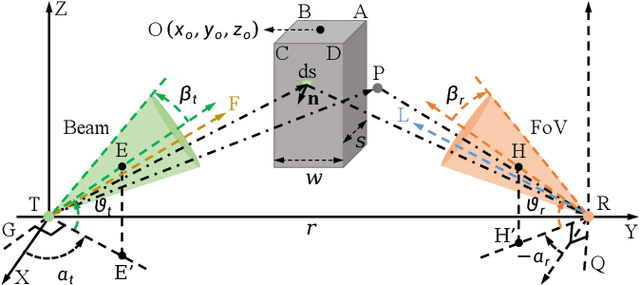
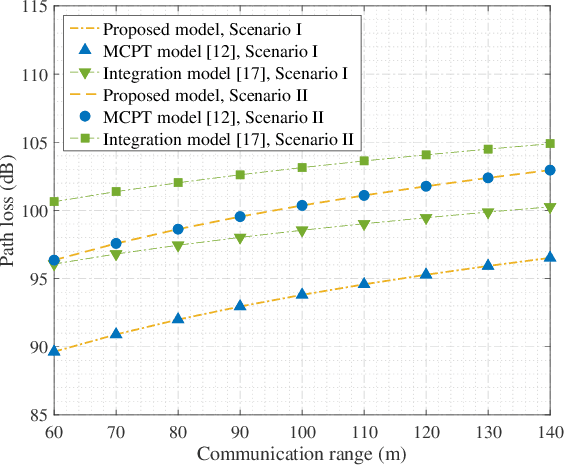
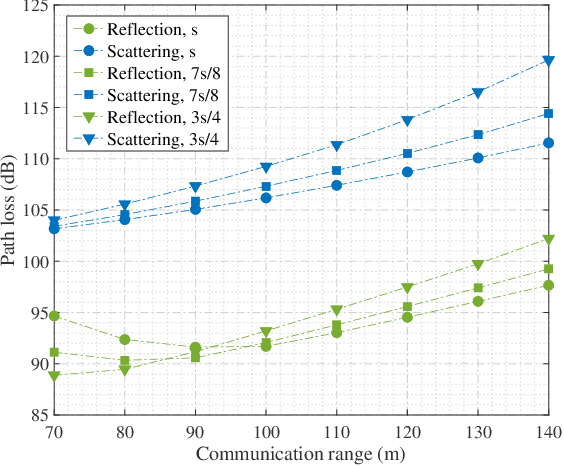
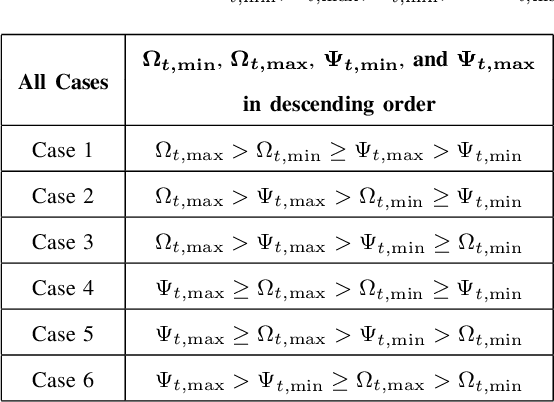
Abstract:Existing studies on ultraviolet (UV) non-line-of-sight (NLoS) channel modeling primarily focus on scenarios without any obstacle, which makes them unsuitable for small transceiver elevation angles in most cases. To address this issue, a UV NLoS channel model incorporating an obstacle was investigated in this paper, where the impacts of atmospheric scattering and obstacle reflection on UV signals were both taken into account. To validate the proposed model, we compared it to the related Monte-Carlo photon-tracing (MCPT) model that had been verified by outdoor experiments. Numerical results manifest that the path loss curves obtained by the proposed model agree well with those determined by the MCPT model, while its computation complexity is lower than that of the MCPT model. This work discloses that obstacle reflection can effectively reduce the channel path loss of UV NLoS communication systems.
Single-Collision Model for Non-Line-of-Sight UV Communication Channel With Obstacle
Nov 08, 2024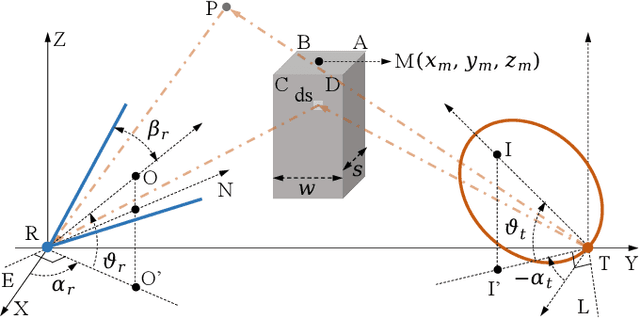
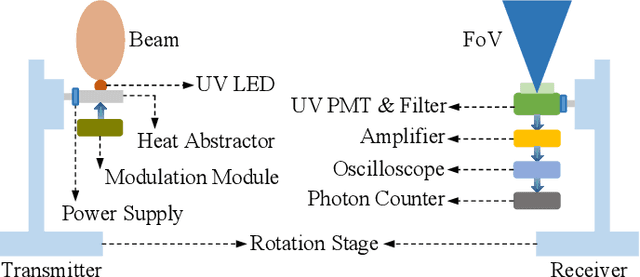
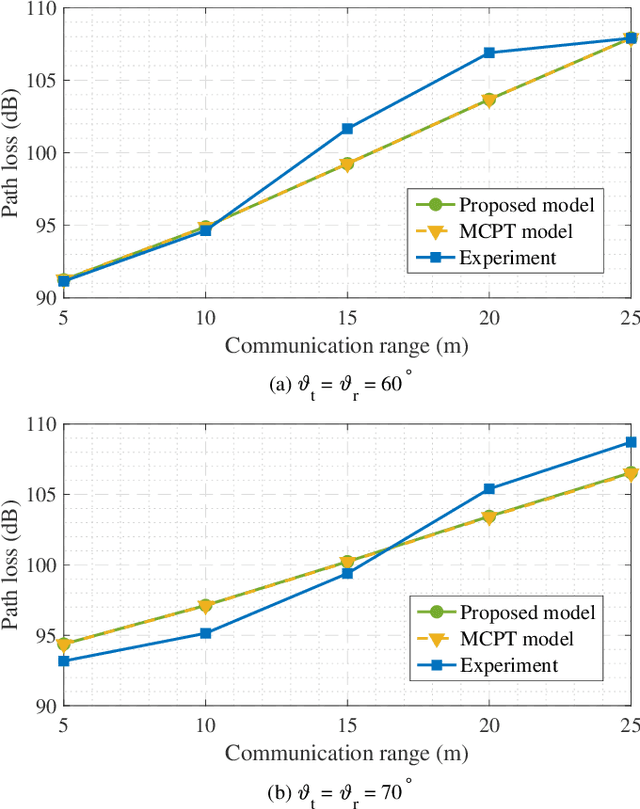
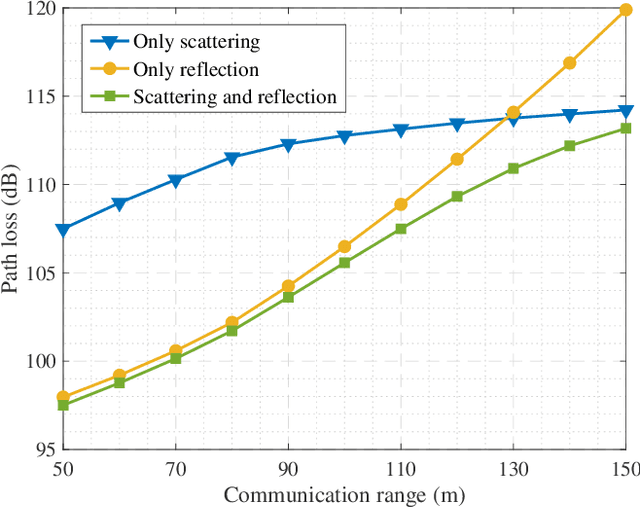
Abstract:Existing research on non-line-of-sight (NLoS) ultraviolet (UV) channel modeling mainly focuses on scenarios where the signal propagation process is not affected by any obstacle and the radiation intensity (RI) of the light source is uniformly distributed. To eliminate these restrictions, we propose a single-collision model for the NLoS UV channel incorporating a cuboid-shaped obstacle, where the RI of the UV light source is modeled as the Lambertian distribution. For easy interpretation, we categorize the intersection circumstances between the receiver field-of-view and the obstacle into six cases and provide derivations of the weighting factor for each case. To investigate the accuracy of the proposed model, we compare it with the associated Monte Carlo photon tracing model via simulations and experiments. Results verify the correctness of the proposed model. This work reveals that obstacle avoidance is not always beneficial for NLoS UV communications and provides guidelines for relevant system design.
 Add to Chrome
Add to Chrome Add to Firefox
Add to Firefox Add to Edge
Add to Edge